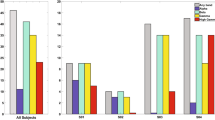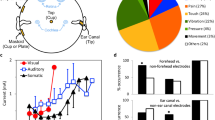Abstract
Arrays of platinum (faradaic) and anodized, sintered tantalum pentoxide (capacitor) electrodes were implanted bilaterally in the subdural space of the parietal cortex of the cat. Two weeks after implantation both types of electrodes were pulsed for seven hours with identical waveforms consisting of controlled-current, chargebalanced, symmetric, anodic-first pulse pairs, 400 μsec/phase and a charge density of 80–100 μC/cm2 (microcoulombs per square cm) at 50 pps (pulses per second). One group of animals was sacrificed immediately following stimulation and a second smaller group one week after stimulation. Tissues beneath both types of pulsed electrodes were damaged, but the difference in damage for the two electrode types was not statistically significant. Tissue beneath unpulsed electrodes was normal. At the ultrastructural level, in animals killed immediately after stimulation, shrunken and hyperchromic neurons were intermixed with neurons showing early intracellular edema. Glial cells appeared essentially normal. In animals killed one week after stimulation most of the damaged neurons had recovered, but the presence of shrunken, vacuolated and degenerating neurons showed that some of the cells were damaged irreversibly. It is concluded that most of the neural damage from stimulations of the brain surface at the level used in this study derives from processes associated with passage of the stimulus current through tissue, such as neuronal hyperactivity rather than electrochemical reactions associated with current injection across the electrode-tissue interface, since such reactions occur only with the faradaic electrodes.
Similar content being viewed by others
Explore related subjects
Discover the latest articles and news from researchers in related subjects, suggested using machine learning.References
Agnew, W.F.; McCreery, D.B. Consideration for safety in the use of extracranial stimulation for motor evoked potentials. Neurosurg. 20:143–147; 1987.
Agnew, W.F.; Yuen, T.G.H.; McCreery, D.B. Morphologic changes after prolonged electrical stimulation of the cat's cortex at defined charge densities. Exp. Neurol. 79:397–411; 1983.
Agnew, W.F.; Yuen, T.G.H.; Bullara, L.A.; Jacques, D.; Pudenz, R.H. Intracellular calcium deposition in brain following electrical stimulation. Neurol. Res. 1:187–202; 1979.
Agnew, W.F.; Yuen, T.G.H.; Pudenz, R.H.; Bullara, L.A. Electrical stimulation of the brain: IV. Ultrastructural studies. Surg. Neurol. 4:438–448; 1975.
Auer, R.N. Hypoglycemic brain damage. Doctoral Thesis, University of Lund; 1985.
Auer, R.N.; Wieloch, T.; Olsson, Y.; Siesjo, B.K. The distribution of hypoglycemic brain damage. Acta. Neuropath. 64:177–191; 1984.
Bartlett, J.R.; Doty, R.W.; Lee, B.B.; Negrao, N.; Overman, W.H. Deleterious effects of prolonged electrical excitation of striate cortex in Macaques. Brain Behav. & Evol. 14:46–66; 1977.
Bernstein, J.J.; Hench, L.L.; Johnson, P.F.; Dawson, W.W.; Hunter, G. Electrical stimulation of the cortex with tantalum pentoxide capacitor electrodes. In: Hambrect, F.T.; Reswick, J.B., eds. Functional Electrical Stimulation. New York: Marcel Dekker, Inc.; Basel 1977.
Brummer, S.B.; Turner, M.J. Electrical stimulation with Pt electrodes; analysis of dissolved platinum and other dissolved electrochemical products. Brain, Behav. & Evol. 14:23–45; 1977.
Brummer, S.B.; Turner, M.J. Electrical stimulation with Pt electrodes. II. Estimation of maximum surface redox (theoretical non-gassing) limits. IEEE Trans. Biomed. Engr. BME 24: 440–443; 1977a.
Brummer, S.B.; Turner, M.J. Electrochemical considerations for safe electrical stimulation of the nervous system with platinum electrodes. IEEE Trans. Biomed. Eng. 24:59–63; 1977b.
Guyton, D.L.; Hambrecht, F.T. Theory and design of capacitor electrodes for chronic stimulation. Med. Biol. Engr. 12:613–620; 1974.
Guyton, D.L.; Hambrecht, F.T. Capacitor electrodes stimulate nerve or muscle without oxidation-reduction reactions. Science (United States) 6. 181:74–76; 1973.
Johnson, P.F.; Bernstein, J.J.; Hunter, G.; Dawson, W.W.; Hench, L.L. Anin vitro andin vivo analysis of anodized tantalum capacitive electrodes: Corrosion response, physiology, and histology. J. Biomed. Mater. Res. 11:637–656; 1977.
Lamb, B.S.; Webb, R.C. Vascular effects of free radicals generated by electrical stimulation. Am. J. Physiol. 247:709–714; 1984.
Lassman, H.; Petsche, U.; Kitz, K.; Baran, H.; Sperl, G.; Settelberger, F.; Hornykiewicz, O. The role of brain edema in epileptic brain damage induced by systemic kainic acid injection. Neuroscience 13:691–704; 1984.
McCreery, D.B.; Agnew, W.F. Changes in the extracellular potassium and calcium concentration and neural activity during prolonged electrical stimulation of the cat cerebral cortex at defined charge densities. Exp. Neurol. 79:371–396; 1983.
Miyazaki, S.; Ikeda, K. Capacitive electrode for chronic stimulation of nerve. Rep. Inst. Med. Dent. Eng. 63–74; 1974.
Olney, J.W.; de Gubareff, T. “Epileptic” brain damage in rats induced by sustained electrical stimulation of the perforant pathway. II. Ultrastructural analysis of acute hippocampal pathology. Brain Res. Bul. 10:699–712; 1983.
Olney, J.W.; Fuller, T.A.; de Gubareff, T. Kainate-like neurotoxicity of folates. Nature. 292:165–167; 1981.
Petito, C.K.; Pulsinelli, W.A.; Jacobson, G.; Plum, F. Edema and vascular permeability in cerebral ischemia: Comparison between ischemic neuronal damage and infarction. J. Neuropth. Exper. Neurol. 41:423–436; 1982.
Pinard, E.; Tremblay, E.; Ben-Ari, Y.; Seylaz, J. Blood flow compensates oxygen demand in the vulnerable CA3 region of the hippocampus during kainate-induced seizures. Neuroscience 13:1039–1049; 1984.
Pudenz, R.H.; Agnew, W.F.; Bullara, L.A. Effects of electrical stimulation of the brain. Brain Behavior and Evol. 14:103–135; 1977.
Pudenz, R.H.; Bullara, L.A.; Jacques, D.; Hambrecht, F.T. Electrical stimulation of the brain III: The neural damage model. Surg. Neurol. 4:384–400; 1975.
Robblee, L.S.; Kelliher, E.M.; Langmuir, M.E.; Vartanian, H.; McHardy, J. Preparation of etched tantalum semimicro capacitor stimulation electrodes. EIC Laboratories, Inc., Newton, MA. J. Biomed. Mater. Res. (United States). 17:327–343; 1983.
Robblee, L.S.; McHardy, J.; Agnew, W.F.; Bullara, L.A. Electrical stimulation with Pt electrodes. VII. Dissolution of Pt electrodes during electrical stimulation of the cat cerebral cortex. J. Neurosci. Meth. 9:301–330; 1983.
Rose, T.L.; Kelliher, E.M.; Robblee, L.S. Assessment of capacitor electrodes for intracortical neural stimulation. EIC Laboratories, Inc., Norwood, MA 02062. J. Neurosci. Meth. (Netherlands) 12:181–193; 1985.
Schmidt, E.M.; Hambrecht, F.T.; McIntosh, J.S. Intracortical capacitor electrodes: Preliminary evaluation. J. Neurosci. Methods 5:33–39; 1982.
Sloviter, R.S.; Damiano, B.P. On the relationship between kainic acid-induced electrophysiological effects and hippocampal damage in rats. Neurosci. Lett. 24:279–284; 1981.
Young, R.R.; Cracco, R.Q. Clinical neurophysiology of conduction in central motor pathways. Ann. Neurol. 18:606–610; 1985.
Yuen, T.G.H.; Agnew, W.F.; Bullara, L.A.; Jacques, D.; McCreery, D.B. Histological evaluation of neural damage from electrical stimulation: Considerations for the selection of parameters for clinical application. Neurosurg. 9:292–299; 1981.
Author information
Authors and Affiliations
Rights and permissions
About this article
Cite this article
McCreery, D.B., Agnew, W.F., Yuen, T.G.H. et al. Comparison of neural damage induced by electrical stimulation with faradaic and capacitor electrodes. Ann Biomed Eng 16, 463–481 (1988). https://doi.org/10.1007/BF02368010
Received:
Revised:
Issue Date:
DOI: https://doi.org/10.1007/BF02368010




